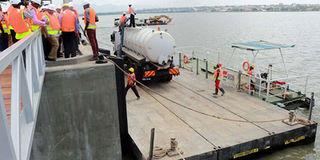Breaking News: At least 10 feared to have drowned in Makueni river
Kisumu oil jetty flaws undermines export plans

Government officers inspect Kisumu Oil Jetty on February 28, 2018. The facility has been deemed unfit for use. PHOTO | FILE | NATION MEDIA GROUP
What you need to know:
- The report notes that the facility was fitted with low-capacity pipes and pumps used for loading trucks instead of the recommended ones for loading ships.
- Investigations into comparative costs have established that the Kisumu facility cost almost three times as much as similar facilities in Africa.
Kenya's is unlikely to achieve its dream of exporting oil to its East African neighbours if the Kisumu oil jetty is not operational by June 2019, when Uganda commissions its own jetty.
It has emerged that the Sh1.7 billion facility, launched by President Uhuru Kenyatta last year, has serious flaws, according to an experts’ report.
It singles out poor workmanship, lack of mandatory facilities like firefighting equipment, lack of provision for spillage and inappropriate equipment as the major problems.
The report notes that the facility was fitted with low-capacity pipes and pumps used for loading trucks instead of the recommended ones for loading ships.
DEFECTIVE
Consequently, loading a standard 4.2 million-litre oil barge will take 32 hours instead of four.
"Jetties are standard worldwide and the Kisumu jetty doesn't meet the requisite standards. There are no dedicated pumps for ship loading. We observed that existing pumps for truck loading have been connected to ship-loading operations.
"As per this arrangement, only one operation, either ship loading or truck loading, is possible at a time. This means that ship loading should be stopped during truck loading or truck loading should be stopped during ship loading.
"Both operations are regularly required as ship loading as well as truck loading are done on a day-to-day basis. This severely restricts the throughput capacity of the Kisumu terminal and will also hamper ship and truck loading operations,” the report, currently in the hands of the Directorate of Criminal Investigations (DCI), says.
MISMANAGEMENT
Besides, the jetty lacks mandatory safety facilities in case of spillage or fires. “It is strongly recommended that the operation of a sprinkler system be made automatic, with provisions for temperature sensors and motor-operated valves,” the report says, adding that unless these shortcomings are addressed no oil tanker should be allowed to use the jetty.
When members of the National Assembly’s Committee on Energy chaired by Nakuru Town East MP David Gikaria toured the facility last Friday, they accused the Kenya Pipeline Corporation (KPC) management of obstructing investigations into the costing of the facility by not presenting some of the documents they had asked for.
“As an oversight committee, we wanted to look at the documentation on the construction and tendering and variations. Initially, KPC intended to construct the jetty internally, bought some equipment and material but later awarded a contract for the same.
"We want to know where the materials are, and whether they were also given to the contractor,” Mr Gikaria said after a meeting with KPC acting MD Hudson Andambi and Chairman John Ngumi.
PROBE
Investigations by the DCI found the facility deficient.
Uganda, which was expected to be the main client, is working on its own 69 million-litre capacity storage, international standard jetty and four 4.2 million-litre barges.
The facilities are being put up by Mahathi Infra Services Pvt Ltd, an Indian company. The jetty is scheduled for completion in April.
Meanwhile two of the barges should be ready by end of June this year and the other two by October.
It is notable that the Indian company, which has built oil jetties in Mozambique and Gabon, conducted a feasibility study for the Kisumu oil jetty but did not win the tender for its construction.
The tender for the Kisumu jetty was awarded to Southern Engineering Co Ltd, a Mombasa-based firm with little-known experience in the construction of such facilities.
FUEL SHORTAGE
Investigations into comparative costs have established that the Kisumu facility cost almost three times as much as similar facilities in Africa.
The Uganda jetty, including its storage tanks, cost about Sh600 million.
According to the report, taxpayers will have to release another Sh500 million to make the Kisumu oil jetty usable.
After the completion of Uganda's jetty in Port Bell, the country and its neighbours - Rwanda, Burundi and the Democratic Republic of Congo - can expect to be spared fuel shortages they sometimes experience, especially during periods of unrest in Kenya.
However, the jetty’s launch is dependent on the completion of the Kisumu facility.
Meanwhile, reports indicate that Tanzania is preparing to use its Mwanza depot to compete with Kenya's jetty.
While the Kisumu jetty was supposed to ease the transportation of fuel to Uganda and neighbouring countries by allowing ships to load fuel from Kisumu and transport it to the Ugandan jetty, this will have to wait because it is not clear when the jetty’s structural weaknesses will be rectified.





